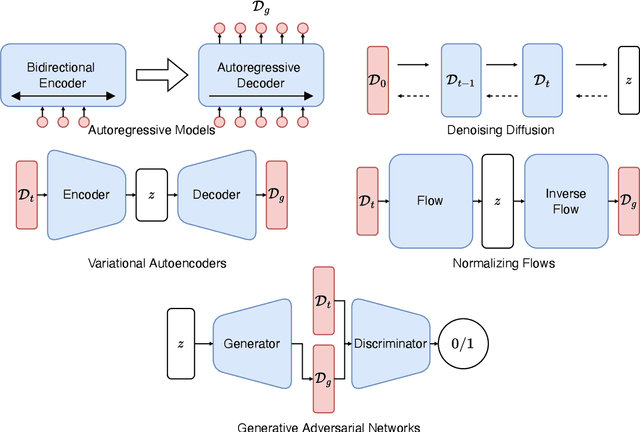Hosein Hashemi
Deep Generative Models for Detector Signature Simulation: An Analytical Taxonomy
Dec 15, 2023


Abstract:In modern collider experiments, the quest to explore fundamental interactions between elementary particles has reached unparalleled levels of precision. Signatures from particle physics detectors are low-level objects encoding the physics of collisions. The complete simulation of them in a detector is a memory and storage-intensive task. To address this computational bottleneck in particle physics, "Fast Simulation" has been introduced and refined over the years. The field has seen a surge in interest in surrogate modeling the detector simulation, fueled by the advancements in deep generative models. These models aim to generate responses that are statistically identical to the observed data. In this paper, we conduct a comprehensive and exhaustive taxonomic review of the existing literature on the simulation of detector signatures from both methodological and application-wise perspectives. Initially, we formulate the problem of detector signature simulation and discuss its different variations that can be unified. Next, we classify the state-of-the-art methods into four distinct categories based on their underlying model architectures, summarizing their respective generation strategies. We then identify and discuss three key application areas. Finally, we shed light on the challenges and opportunities that lie ahead in detector signature simulation, setting the stage for future research and development.
Ultra-High-Resolution Detector Simulation with Intra-Event Aware GAN and Self-Supervised Relational Reasoning
Mar 07, 2023Abstract:Simulating high-resolution detector responses is a storage-costly and computationally intensive process that has long been challenging in particle physics. Despite the ability of deep generative models to make this process more cost-efficient, ultra-high-resolution detector simulation still proves to be difficult as it contains correlated and fine-grained mutual information within an event. To overcome these limitations, we propose Intra-Event Aware GAN (IEA-GAN), a novel fusion of Self-Supervised Learning and Generative Adversarial Networks. IEA-GAN presents a Relational Reasoning Module that approximates the concept of an ''event'' in detector simulation, allowing for the generation of correlated layer-dependent contextualized images for high-resolution detector responses with a proper relational inductive bias. IEA-GAN also introduces a new intra-event aware loss and a Uniformity loss, resulting in significant enhancements to image fidelity and diversity. We demonstrate IEA-GAN's application in generating sensor-dependent images for the high-granularity Pixel Vertex Detector (PXD), with more than 7.5M information channels and a non-trivial geometry, at the Belle II Experiment. Applications of this work include controllable simulation-based inference and event generation, high-granularity detector simulation such as at the HL-LHC (High Luminosity LHC), and fine-grained density estimation and sampling. To the best of our knowledge, IEA-GAN is the first algorithm for faithful ultra-high-resolution detector simulation with event-based reasoning.
PE-GAN: Prior Embedding GAN for PXD images at Belle II
Mar 01, 2023



Abstract:The pixel vertex detector (PXD) is an essential part of the Belle II detector recording particle positions. Data from the PXD and other sensors allow us to reconstruct particle tracks and decay vertices. The effect of background hits on track reconstruction is simulated by adding measured or simulated background hit patterns to the hits produced by simulated signal particles. This model requires a large set of statistically independent PXD background noise samples to avoid a systematic bias of reconstructed tracks. However, data from the fine-grained PXD requires a substantial amount of storage. As an efficient way of producing background noise, we explore the idea of an on-demand PXD background generator using conditional Generative Adversarial Networks (GANs) with contrastive learning, adapted by the number of PXD sensors in order to both increase the image fidelity and produce sensor-dependent PXD hitmaps.
 Add to Chrome
Add to Chrome Add to Firefox
Add to Firefox Add to Edge
Add to Edge